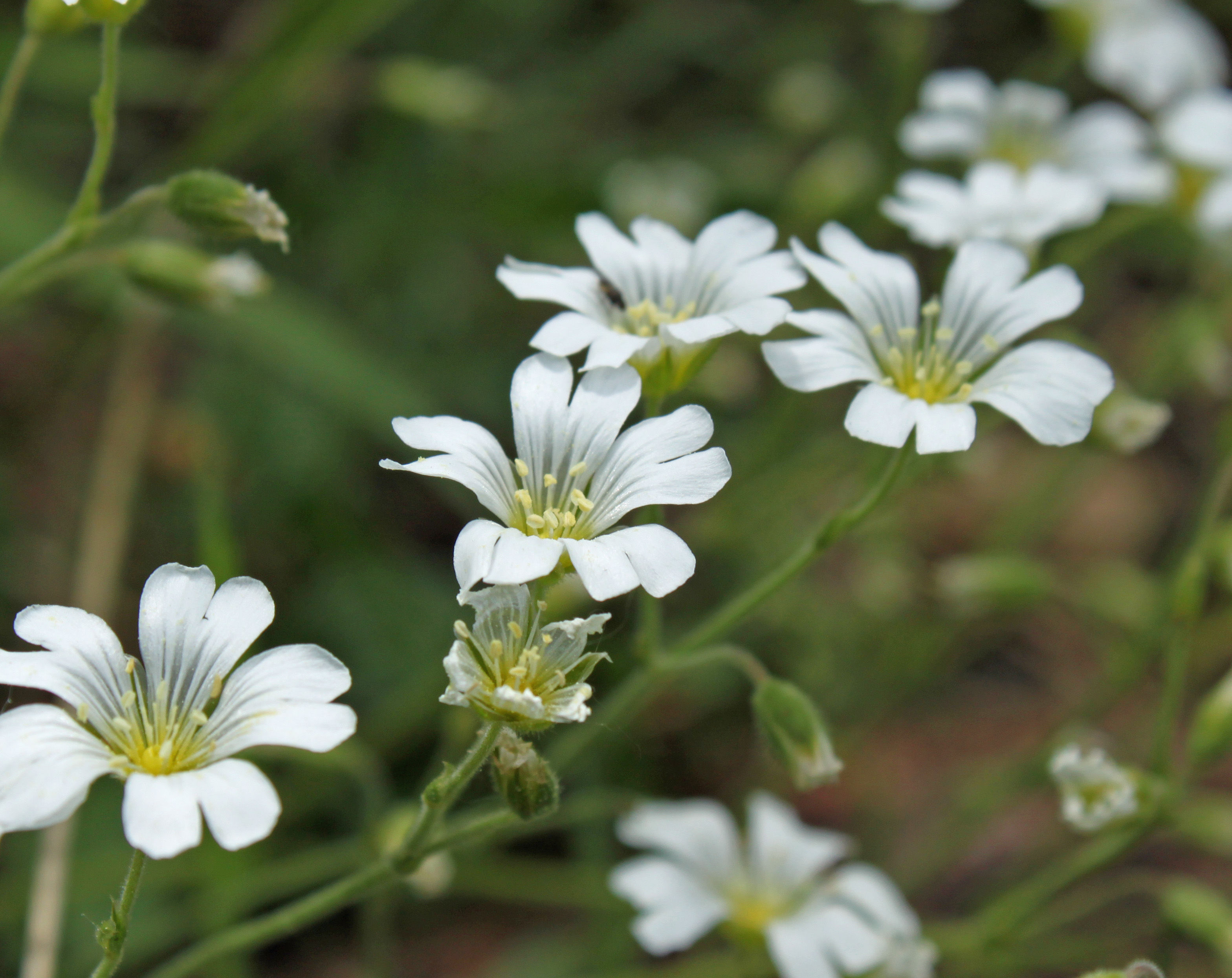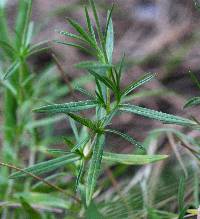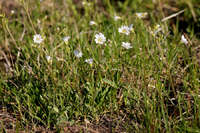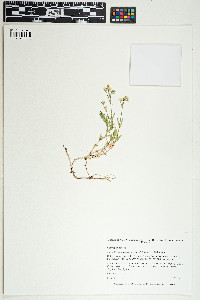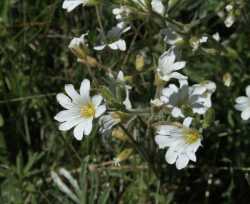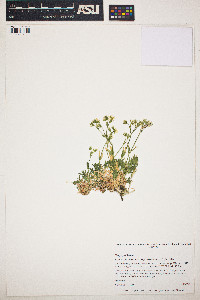Search
Cerastium arvense
|
|
|
|
Family: Caryophyllaceae
field chickweed
|
Plants perennial, clumped and taprooted, or mat-forming and long-creeping rhizomatous. Stems: flowering shoots often decumbent proximally, 5-20(-30) cm, glandular-pubescent distally, pilose-subglabrous, deflexed or spreading proximally; non-flowering shoots present; small tufts of leaves present in axils of proximal leaves. Leaves not marcescent, sessile, ± spatulate proximally; blade linear-lanceolate to lanceolate or narrowly oblong, 4-30 × 0.5-6 mm, apex acute, rarely obtuse, subglabrous to softly pubescent, sometimes glandular. Inflorescences lax, 1-20-flowered cymes, pubescence short, glandular; bracts lanceolate, margins narrow, scarious, glandular-pubescent. Pedicels curved just below calyx, 5-30 mm, 1-6 times as long as sepals, glandular-pubescent. Flowers: sepals narrowly lanceolate to lance-elliptic, 3.5-7 mm, margins narrow, softly pubescent; petals obovate, 7.5-12.5 mm, ca. 2 times as long as sepals, apex 2-fid; stamens 10; anthers 0.8-1.1 mm; styles 5. Capsules cylindric, curved, 7.5-11.5 × 2.5-4 mm, (1-)1.5-2 times as long as sepals; teeth 10, erect, margins convolute. Seeds brown, 0.6-1.2 mm diam., tuberculate; testa not inflated. 2n = 36, 72, (108, Europe). Perennial herb with a slender taproot or creeping rhizome, clumped or mat-forming 15 - 40 cm tall Stem: upright or ascending, branched at the base, sometimes densely hairy and often glandular. Leaves: opposite, stalkless, 2 - 7 cm long, 1 - 15 mm wide, linear to lance-shaped to narrowly egg-shaped with a pointed tip, nearly hairless to softly hairy, sometimes glandular. Inflorescence: a lax, hairy- and glandular-branched cluster (cyme) of one to twenty flowers subtended by lance-shaped, scarious (dry, thin, and membranous) bracts. Flowers: white. Stalk 0.5 - 3 cm long, glandular-hairy. Stamens ten. Styles five. Sepals: five, distinct, 3.5 - 8 mm long, narrowly lance-shaped with a pointed tip, softly hairy. Petals: five, white, 7.5 - 12.5 mm long (usually more than 10 mm long and two to three times as long as the sepals), reverse egg-shaped, two-lobed, clawed. Fruit: a dehiscent capsule (opening by ten short teeth), 7.5 - 11.5 mm long, longer than the sepals, cylindrical, more or less curved. Seeds numerous, brown, egg- to kidney-shaped, dorsally grooved. Similar species: Having some or all of the bracts with scarious margins (or at least the upper part of the bracts) helps to distinguish this species, Cerastium fontanum ssp. vulgare, C. pumilum, and C. semidecandrum from most other Cerastium in the Chicago Region. Cerastium fontanum ssp. vulgare, C. pumilum, and C. semidecandrum differ from C. arvense by having petals that are less than 10 mm long. The variety villosissimum is a much hairier plant. Flowering: May to early June Habitat and ecology: Sandy prairies, old fields, and open woods. In the Chicago Region, it is usually seen on riverbanks and rock outcrops. Occurence in the Chicago region: native Etymology: Cerastium comes from the Greek word keras, meaning horn, referring to the horn-like shape of the seed capsule. Arvense means "of farmed or cultivated fields." Author: The Morton Arboretum Glabrous to densely villous and often glandular perennial, ascending or erect, 1.5-4(-6) dm, branched and often matted at the base; lvs linear to narrowly ovate, 2-7 cm 1-15 mm, usually subtending conspicuous axillary fascicles or short shoots; sep lanceolate, acute, 5-8 mm; pet conspicuous, white, bilobed, 2-3 times as long as the sep; polyploid series based on x=18 (or 9?). Rocky, gravelly, or sandy places, especially in calcareous or magnesian soils, often a weed in abandoned fields and meadows; throughout most of the north-temperate and boreal regions. Apr.-Aug. Highly variable, and often segregated into numerous confluent spp. or vars. (C. campestre; C. oreophilum; C. strictum; C. velutinum) An extremely villous phase on serpentine in se. Pa. and ne. Md. is var. villosissimum Pennell. Gleason, Henry A. & Cronquist, Arthur J. 1991. Manual of vascular plants of northeastern United States and adjacent Canada. lxxv + 910 pp. ©The New York Botanical Garden. All rights reserved. Used by permission. Martin and Hutchins 1980, Welsh et al. 1993, Kearney and Peebles 1969 Duration: Perennial Nativity: Non-Native Lifeform: Forb/Herb General: Perennial forming loose to dense clumps, 10-40 cm across, on stems decumbent to erect and ascending to 30 cm tall, herbage retrorse-pubescent to glabrous to hairy on middle internodes, and densely glandular upward. Leaves: Opposite, linear-subulate to narrowly oblong to lanceolate, 10-25 mm long, 1-4 mm wide, 1-veined, pubescent on both sides, ciliate and acute, cauline leaves with sterile axillary shoots. Flowers: Erect, inflorescence a few-flowered cyme with erect to nodding pedicels, glandular hairy, bracts scarious margined, sepals 4-8 mm long, glandular, scarious margined, 5 petals twice as long as sepals, white, 8-12 mm, deeply bilobed. Fruits: Capsule straight, 6-10 mm long, cylindric with reddish seeds. Ecology: Found in wet meadows, moist woods, disturbed sites, to dry sites from 7,000-9,500 ft (2134-2896 m); flowers June-August. Notes: The glandular herbage, the delicate white flowers with 5 petals and the opposite leaves help to distinguish this species. There are a number of Cerastium that are native to the region. Ethnobotany: Used as an aid to women in birth to stop bleeding, as an astringent, and for injuries or miscarriages. Etymology: Cerastium is from the Greek keras, a horn, while arvense means of the field. Synonyms: None Editor: SBuckley, 2010 |

